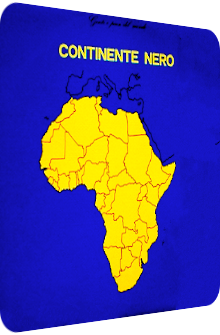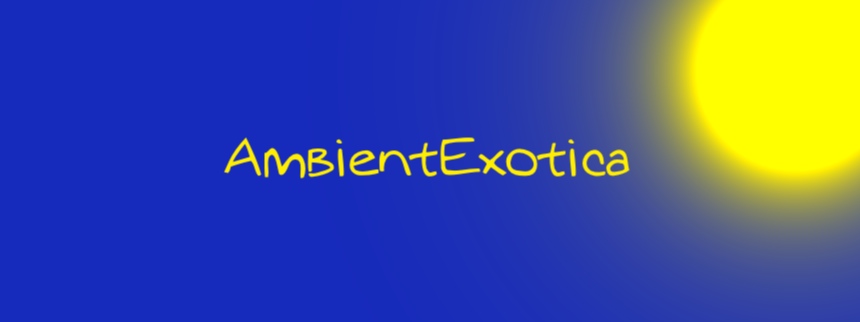
Piero Umiliani
Continente Nero
1975
Occasionally, arrangers and bandleaders with ties to the Exotica genre revisit a certain sound or idea, not necessarily due to pressure from the upper floors of a record label or in order to cash in, but rather because there has not been said everything about a topic. This admittedly overly romantic and naïve approach culminates in clarinetist and composer Robert Drasnin’s Voodoo! (1959) which sees a resurrection a mere 48 years later in the shape of Voodoo II, a record for the Guinness Book that stands out in the realms of Exotica and is unlikely to ever be repeated, let alone beaten. By contrast, the impetus of Italian composer and film scorer Piero Umiliani (1926–2001) revisiting a specific theme is much smaller, albeit welcome.
After the delivery of his simple-titled Africa (1972) which he recorded using the alias M. Zalla, Umiliani decides to serve the listener an additional dish of a whopping 16 tunes on Continente Nero, released three years later on the composer’s own Rome-based Omicron label in 1975. Harkening back to the predecessor’s triptych of Ambient compositions fueled by one or two instruments, drum-only tribal rhythms and the blending of these two styles, Continente Nero offers, as the adage goes, “more of the same,” but is keener on ambivalent twilight moods and dun-colored timbres. Uniting synthesizers with kalimbas, warbled flutes with off-key Honky Tonk pianos and dubbed horn layers with jazzy double bass streamlets, Continente Nero makes use of the varied synergy that already graced Umiliani’s Polinesia (1975). Here is a closer look at Umiliani’s African library music.
Absolutely no time is wasted in the foreboding opener Rivoluzionari which starts in medias res, imposing hammering piano chords coated in synthesizer alloys and seemingly alatoric bongo accompaniments right from the get-go. Typically jazzy double bass billows move in close proximity to the fast-paced hectic. Tension is in the air as Umiliani admixes the nature of his Jazz scores into this turmoil. With Nel Villaggio (in the village), mountainous peacefulness traverses through the album. Marimbas, moist shell percussion, double bass backdrops and bongos altogether create a melancholic panorama, with Nuove Realtà (new realities) offering a particularly interesting simultaneity of elastically bouncing percussion glitters, elastic square lead pads, warbled flutes and rhythm marimbas. Bubbling drums and a synth choir round off a tune which is as shady as it is foreshadowing.
Whereas the impressive Antiche Tradizioni (ancient traditions) seems to be a lost take off the Roger Roger Ensemble’s Afro, Spooky (1974) due to its ardored synth mirage, the ghostly boo-bams, classic drums and percussive star dust, the equally magnificent Nuovi Fermenti (new brew) drugs the listener and accrues an inebriated state in the shapes of Manhattan-style trumpets and distant horns, galactic piano helixes and frizzling hi-hats. It is poignant that this alcoholic composition is the only one with a hopeful spirit (!), methinks. After the lacunar stop-and-go percussion prowess of Sole Percussioni, two flute solos called Piffero Africano and Continente Nero follow, the latter one being rearranged later on side B.
Said side B kicks off with the adventurous Riscossa (the rescue), a gorgeous synth-less Exotica tune with a towering brass euphony, silkened hi-hats and golden piano globs, not unlike car chase themes. Ultimo Stregone (the last sorcerer) is less enigmatic than its title suggests; the opposite is the case, as Umiliani brews an enchanting concoction of bongo-accompanied flute melodies, quasi-brazen synth prongs and double bass rivers. The second incarnation of Continente Nero follows, keeping the melody intact but bolstering the former flute solo with off-key oud strings, reverberated vault-like shell percussion and aqueous bass slaps, all the while the war-insinuating Preparativi (preparations) is a tense work loaded with quavering dragonfly-evoking strings, crepuscular bongos and a rising pompousness.
Oasi is another strongly exotic composition based on four ingredients: oscillating cowbells, bass protrusions in tandem with dark piano keys, snake-like shakers and freedom flutes, but it is the following Ambient erection called Tribalismo which is more akin to an oasis as it sports duskily droning flute washes plus synth flumes of the New Age kind and intermixes them with short instances of shell glitters. Haunting and majestic at the same time, Tribalismo is the standout. Giorno Di Mercato (market day) is a longform percussion and drum piece that is just shy of the four minute mark, with the finale Flauto Africano giving away its twist via its title: a Pagan flute solo advocates contemplation, balance and vastness at the same time.
Rather serious, definitely spheroidal and eminently versatile, Continente Nero is a great addendum to Africa and a feast for drum lovers who cannot get enough of (mostly) drum-focused genre standards such as Les Baxter’s Skins! or Tito Puente’s Top Percussion (both 1957). The album does not respectfully emanate the true roots of highly heterogenous African music in the same way as, for instance, fellow Italian Tony Scott’s ode to Charlie Parker called African Bird: Come Back! Mother Africa (1984) is able to accomplish, but marries the Afro-Cuban drum infestations of the 50’s with the colorful free-form Jazzscapes of the 60’s and the synthetic traces of Italy’s cinecittà sound of the 70’s… yes, that’s polygamy alright! From the jumpy pianorama Rivoluzionari over the contemplative flute formations in the first version of the title track Continente Nero to the wide forsaken shell percussion-accentuated steppes in Tribalismo, the album offers enough silk and oomph to enchant.
Due to its jagged physiognomy, it cannot succeed once the concept of a coherent album is applied, but depending on the listener’s specific need or mood, Umiliani’s semi-cinematic material caters to every specific need an Exotica fan might temporarily crave. Umiliani’s approach will raise the neck hair of devoted musicologists, but ought to be embraced by Exotica fans who want fantasy, adventure and life in their music. Africa contains the more euphonious and euphoric material, Continente Nero is – no pun intended! – a tad darker and its atmospheres less dreamy, but vigor and tense sinews there are aplenty on both of them. Unfortunately, neither Africa nor Continente Nero have made it to Amazon MP3 or iTunes, but the vinyl regularly appears on eBay or GEMM at surprisingly fair prices.
Exotica Review 346: Piero Umiliani – Continente Nero (1975). Originally published on May 31, 2014 at AmbientExotica.com.
